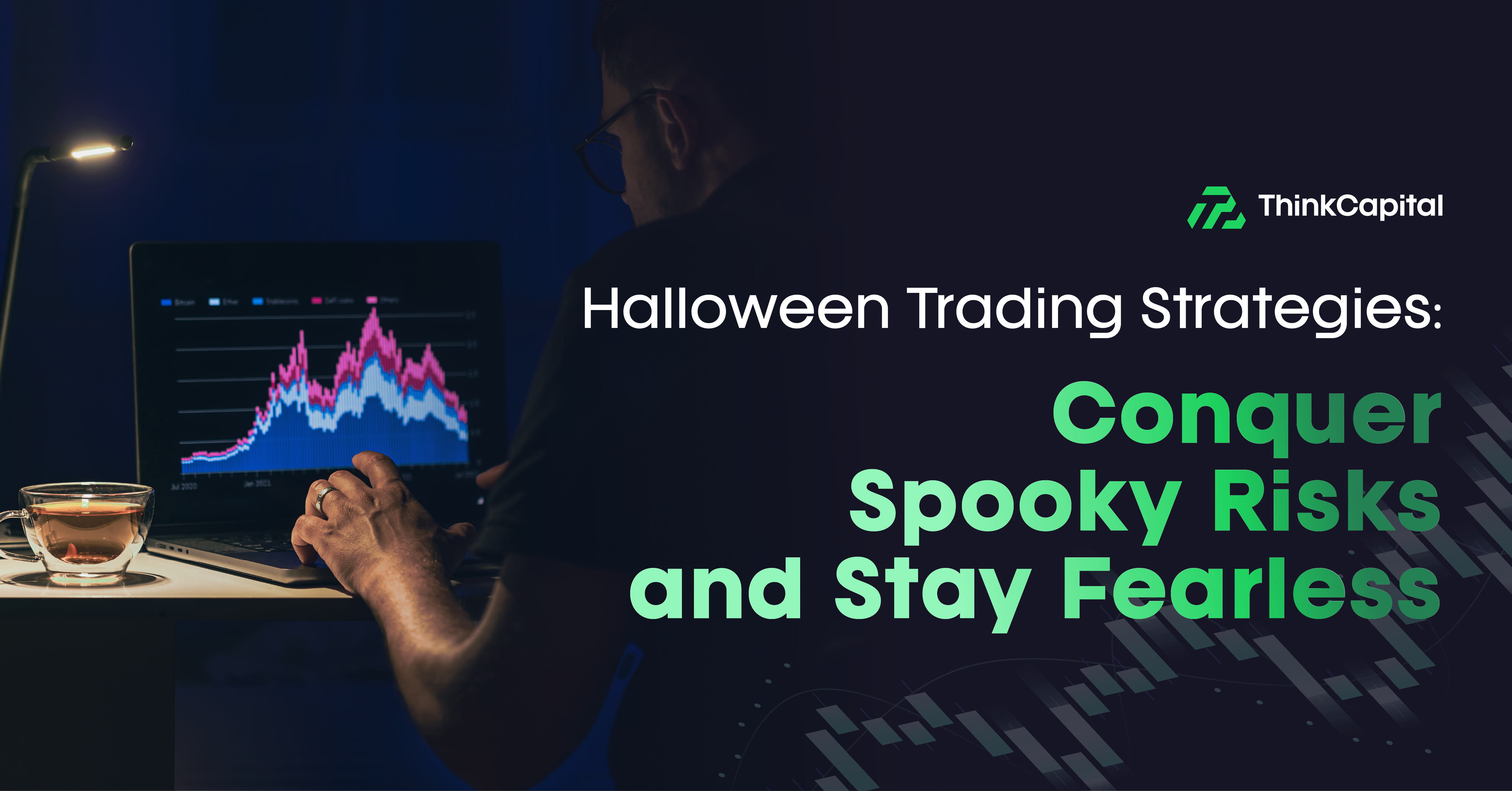Halloween trading strategies help traders navigate the spooky risks and increased market volatility often seen in October. By understanding fear-based trading, managing FOMO, and employing sound risk management techniques, traders can stay fearless and capitalize on market opportunities during the Halloween season.
But beyond the spooky festivities, there’s a well-known seasonal anomaly in the stock market called the Halloween Strategy or Halloween Effect. This investment strategy suggests that stock returns are typically higher during the winter months, specifically from November to April, compared to the summer months.
The Spooky Side of Financial Markets During Halloween
As Halloween approaches, have you ever wondered if the financial markets get a little spooky too? October is historically known for its market volatility—just think of the infamous 1929 crash or 1987’s Black Monday. For traders, Halloween can bring its own set of chills and thrills. But is there really something to fear, or is it just a bunch of hocus-pocus?
Here are a few spooky aspects of Halloween trading:
- Market Volatility: October often sees increased market fluctuations. Historically, the S&P 500 has experienced an average volatility increase of 15% during October compared to other months.
- Fear-Based Trading: The psychological impact of past market crashes can influence trading decisions during this “scary” season.
- Sudden Market Shifts: Sharp movements may be more common, or perhaps traders just anticipate the worst due to historical events.
Understanding the Halloween Strategy and Its Historical Performance

The Halloween Strategy, also known as the Halloween Effect or Halloween Indicator, refers to a market timing strategy where investors buy stocks at the end of October and sell them in April or May. This strategy is based on the observation that the stock market tends to perform better during the November through April period compared to the rest of the year.
Historical data supports this trend, showing that stock prices tend to rise more during the November to April period. Research shows that over many years, the average stock market returns have been significantly higher during these winter months. This seasonal anomaly contradicts the efficient markets hypothesis, which suggests that it’s impossible to consistently achieve returns higher than average market returns on a risk-adjusted basis.
A study published in the American Economic Review found that the Halloween Strategy works across various global markets, including the British stock market and emerging markets. Some theories suggest that this pattern could be due to factors like the holiday buying season, where increased consumer spending boosts corporate earnings, or the presidential election cycle, which can influence market performance.
Frightening Trading Risks and How to Stay Fearless
The “monsters” that haunt traders are often psychological. Let’s identify some common fears and how to conquer them.
1. FOMO: The Ghost That Haunts Every Trader
Fear of Missing Out (FOMO) can push traders into impulsive decisions, especially when they see others making profits.
Tip: Stick to your investment strategy. Remember, there’s always another opportunity around the corner. A consistent plan can keep FOMO at bay.
2. Panic Selling: Don’t Let the Markets Spook You
Sudden market drops can trigger panic selling, causing traders to make rash decisions and sell stocks at a loss.
Tip: Stay informed and keep a level head. Evaluate whether a drop is a short-term fluctuation or a deeper issue. Set stop-loss orders to protect your positions without acting out of fear.
3. Overtrading: Beware the Witch of Overconfidence
Feeling invincible after a few wins? Overconfidence can lead you into the trap of overtrading.
Tip: Keep track of your trades and set strict trading limits. Consistency is the key to avoiding unnecessary risks.
Winning Halloween Trading Strategies
Now that we’ve identified the risks, let’s dive into strategies that can help you stay fearless and make the most of the spooky season.
1. Consider Embracing the Halloween Strategy
Implementing the Halloween Strategy in indices or FX involves looking for bullish patterns at the end of October and holding positions through April. By doing so, you aim to capitalize on the historical trend of higher performance during the winter months.
Tip: Focus on indices like the S&P 500 or NASDAQ (NQ), which are influenced heavily by stock performance during this period. Look for double-bottom or other reversal patterns indicating potential gains. In the FX market, consider currencies correlated with strong economic indicators during the winter months, or align with major central bank policies supporting market optimism.
2. Timing Your Entry: Nailing the Perfect Moment
Timing is everything in trading, especially during volatile times like October.
- Use Technical Indicators: Tools like moving averages and Bollinger Bands can help determine the right time to enter a trade.
- Stay Informed: Keeping an eye on financial markets news can provide insights into potential market movers and help you time your trades effectively.
3. Planning Your Exit: Avoiding Trading Nightmares
Just as important as knowing when to enter is knowing when to exit.
- Set Stop-Loss Orders: Protect yourself from significant losses by placing stop-loss orders at logical support levels.
- Have Profit Targets: Decide in advance when you’ll take profits to avoid the trap of holding on for too long and losing gains.
4. Diversify Your Portfolio: Don’t Bet Everything on One Spell
Diversification is key to reducing risks—even during Halloween.
Tip: Spread your investments across different sectors and asset types, including small-cap securities, bonds, and exchange-traded funds (ETFs) like the iShares ETF series. This minimizes your exposure to any single asset’s volatility.
Managing Trading Fear During Halloween
Fear can be your worst enemy in trading. Here’s how to keep it in check:
- Educate Yourself: The more you know, the less there is to fear. Knowledge helps you approach the stock market logically instead of emotionally.
- Practice Mindfulness: Stay calm and composed to make rational decisions.
- Use a Demo Account: If you’re hesitant, practice your strategies without risking real money. A demo account can help you build confidence. ThinkMarkets offers a free demo account that you can take advantage of.
The Role of Economic Indicators and Market Events
Understanding the broader economic context can help you make better trading decisions.
- Interest Rates and Policy Easing Mode: Central banks may adjust interest rates during this period, impacting the stock market.
- Job Growth and Economic Data: Positive indicators like job growth can boost market confidence.
- Global Slowdown Fears: Be aware of any signs of a market crisis or global slowdown fears that could affect your investments.
Join the Conversation: Share Your Spooky Trading Stories
Have you ever experienced spooky moments in trading? Share your stories in our Discord community! Let’s learn from each other’s experiences and help each other stay fearless.
Frequently Asked Questions About Halloween Trading
Q: Why is October considered a volatile month in trading?
A: October is historically known for significant stock market events like the 1929 crash and Black Monday in 1987, leading to perceptions of higher volatility. Seasonal factors and end-of-year trading behaviors can also contribute to market fluctuations.
Q: How does the Halloween Strategy work?
A: The Halloween Strategy refers to buying stocks at the end of October and selling them in April. This market timing strategy leverages the historical trend where stock returns are higher during the November through April period.
Q: Is the Halloween Strategy effective?
A: While historical data supports the Halloween Strategy, it’s important to consider that past performance does not guarantee future results. Some studies, including those published in the American Economic Review, suggest the strategy has merit, but it’s also challenged by the efficient markets hypothesis.
Conclusion: Stay Fearless with the Halloween Trading Strategies
Halloween doesn’t have to be a scary time in the stock market. With the right trading strategies and a fearless mindset, you can navigate the spooky market movements and come out on top. Whether it’s managing volatility, keeping your cool during sudden drops, or sticking to an investment strategy to avoid FOMO, the Halloween trading strategies discussed can help you trade confidently.
By implementing the Halloween trading strategies, you can turn market volatility into an opportunity rather than a fear. Stay informed, stay disciplined, and most importantly, stay fearless this Halloween season!
Ready to conquer the Halloween markets with confidence? Sign up with ThinkCapital today, take our challenge and trade fearlessly with our expert-backed platform!
Additional Resources
Internal Articles:
- Master Trading Psychology: Ultimate Guide to Forex Risk Management and Discipline
- Forex Technical Analysis Mastery: Your Guide to Reading Charts
External References:
What strategies have you found effective during volatile trading periods? Share your thoughts in our Discord community!
Disclaimer
Trading involves significant risk of loss and is not suitable for all investors. Past performance is not indicative of future results. Always conduct your own research before making any trading decisions.






